How to Fix Beeping Smoke Detectors
Is your beeping smoke detector starting to get to you? We all know what it’s like to experience that periodic single chirp of the smoke alarm while we’re trying to sleep, or the shrill, continuous beep of the alarm from the smoke detector goes off. And when this disturbance is not caused by an actual emergency, you’ll quickly find yourself ready to throw your smoke detector out the window. However, it’s important to note that you should never disconnect your smoke detector, and that there are several easy fixes in order to stop this disturbance. In this article, we take a look at 3 easy fixes to stop your beeping smoke detector, so you can get back to peace and quiet.
Replace the Battery
The need to replace your battery is the most common reason why your smoke detector is periodically chirping. This should be the only reason why you will hear your smoke detector beep in this way, hardwired or battery-powered, and should be able to be easily fixed with the replacement of a battery.
WireChief Electric tells us more on when to try this simple fix:
“As the battery in a smoke alarm gets weak, the smoke alarm will “chirp” about once a minute to let you know that the battery needs to be replaced. Note: Only the device with a low battery will chirp. The other interconnected alarms should be silent.”
Try a Manual Reset

When a battery replacement doesn’t seem to do the trick, your smoke detector may require a manual reset. This goes one step further than the initial battery replacement, and is necessary if your device is having trouble recognizing that its batteries have been replaced.
Koorsen Fire & Safety explains how to perform a manual reset on both hardwired and battery-powered smoke detectors:
“For battery-only detectors, you will need to remove the detector’s batteries, then hold the reset button down for 15-20 seconds. Replace the batteries and reconnect the detector. It will probably beep one time to show that it is connected, but it should not continue to beep after that. If you have a hardwired system, you will need first to turn off the breaker that controls the alarm system and/or disconnect the detector system from the circuit. Remove the battery, then press the reset button and hold it for 15-20 seconds. Reinstall the battery and reconnect that detector to the circuit and turn the breaker on if you turned it off.”
The Alarm May Require Replacement
Every smoke detector has an expiration date, and yours may have hit its limit. Your alarm may be steadily alerting you that it’s reached the end of its life, and requires replacement in order to work effectively.
Bob Vila explains how to tell whether or not your smoke detector needs replacement:
“The smoke detector itself, and not its battery, may require replacement. Most manufacturers design their products to last for about 10 years. After a decade of service, some of the alarm’s components may no longer be functioning properly. While the date printed on the back of the alarm is likely the date of manufacture, not an expiration date, you can still judge the unit’s age by that date.”
Fire-Alert takes pride in equipping homeowners, commercial businesses,, and government buildings with all necessary fire safety devices to ensure the well-being of families and employees across the nation. Reach out to us using our contact form to find out more.
While having adequate fire protection in every building has always been important, the realization of this importance has only grown throughout the years. And while we tend to think that our fire protection systems are completely covered by the inclusion of a fire alarm and a fire extinguisher, this is often not the case. In fact, two entirely separate types of fire protection are designed to come together for full fire protection: Active Fire Protection (AFP) and Passive Fire Protection (PFP). In this article, we take a look at the difference between active and passive fire protection, so you can be confident that your building is completely protected at all times.
Active Fire Protection
Due to the action of actively extinguishing the fire, fire suppression systems are the most obvious examples of Active Fire Protection, with fire alarm systems also being an important part of AFP. And although active fire protection devices may be the most common way to protect your household or commercial building, they should only be part of your fire safety system.
Marco Protection Systems tells us more about how active fire protection works:
“Active Fire Protection consists of the components of fire protection that require some kind of action to work. This action may be manual, like using a fire extinguisher, or automatic like the sprinkler system dousing flames. The action that results from active fire protection is triggered by some sort of alert or signal. The action itself will help contain, suppress, or extinguish a fire that has already started.”
Passive Fire Protection
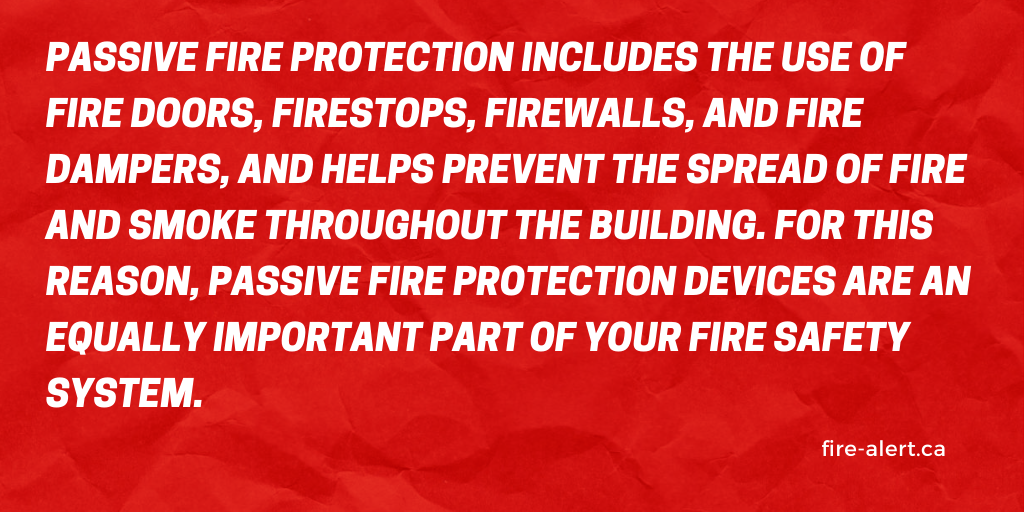
Passive fire protection includes the use of fire doors, firestops, firewalls, and fire dampers, and helps prevent the spread of fire and smoke throughout the building. For this reason, passive fire protection devices are an equally important part of your fire safety system.
Koorsen Fire & Security explains more about the importance of passive fire protection:
“Passive Fire Protection (PFP) also plays an integral role in a comprehensive fire safety system. PFP systems rely on compartmentalization to protect people and minimize damage in the event of a fire. They work by slowing the spread of fire and smoke from one area of a building to another, giving occupants more time to escape and confining the fire where possible.”
Which is Better?
So, which method of fire protector is better, active or passive? The answer is simple: neither. Both fire protection systems must be enforced in either to work together, and neither should be made a priority over the other.
Firetrace tells us why both active and passive fire protection must work together to create a full fire protection system:
“One system is not better than another. Both active and passive fire protection play a key role in protecting buildings, equipment, and people. Passive fire protection is about containing the fire while active fire protection is about stopping the fire. While the systems work independently, but both systems need to be functioning properly to suppress and stop a fire.”
Fire-Alert takes pride in equipping homeowners, commercial businesses, and government buildings with all necessary fire safety devices to ensure the well-being of families and employees across the nation. Reach out to us using our contact form to find out more.
Fire sprinkler system corrosion is a major cause of sprinkler system failures, with 10% of sprinkler system failures caused by corrosion. Fire sprinkler corrosion can result in reduced water flow, pinhole leaks, and sprinkler head or piping blockage and will significantly impair the reliability of your fire sprinkler system in the event of an emergency. So, what causes fire sprinkler corrosion and what can you do about it? Keep reading for our advice on whether you should repair or replace corroded sprinkler pipes, and the best way to prevent fire sprinkler corrosion from occurring in the first place.
What Causes Sprinkler System Corrosion?
What causes fire sprinkler system corrosion in the first place? The fire protection industry has struggled with what is known as the “corrosion triangle” for many years. The corrosion triangle refers to oxygen, metal and water, which is quite plainly a recipe for corrosion. The effects of corrosion can begin as soon as fire sprinkler systems are installed, which is why your fire sprinkler system must be regularly maintained in order to prevent corrosion from getting out of control.
Fireline tells us more about the effects of corrosion on fire sprinkler systems:
“Corrosion creates rust which can cause pinhole-sized holes into metal sprinkler pipes. This is very difficult to notice until it is too late. At the proper temperatures, corrosive elements also contribute to microbiologically induced corrosion, more commonly known as “MIC”, which allows bacteria to colonize your sprinkler systems’ internal surfaces. This, too, can cause leaks and obstructions.”
Should You Repair or Replace Corroded Sprinkler Pipes?
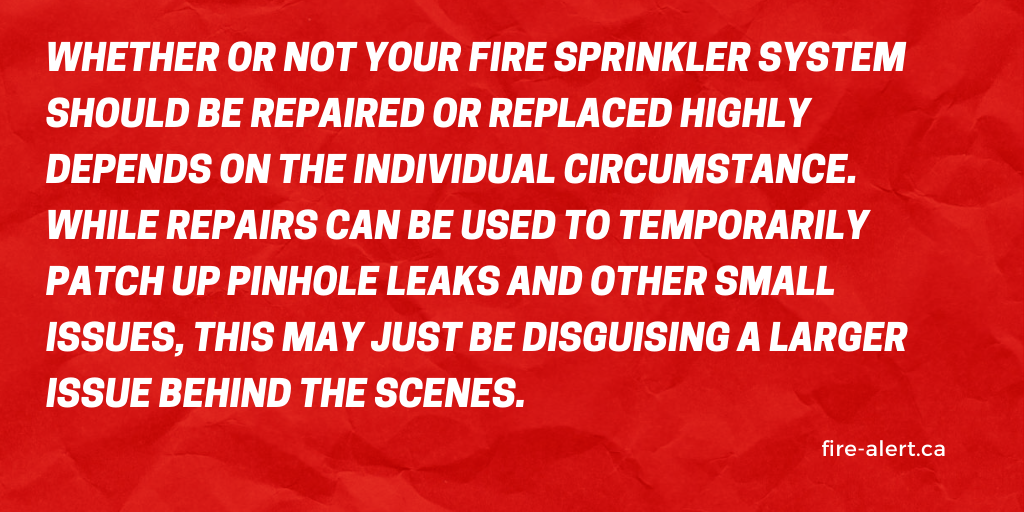
Whether or not your fire sprinkler system should be repaired or replaced highly depends on the individual circumstance. While repairs can be used to temporarily patch up pinhole leaks and other small issues, this may just be disguising a larger issue behind the scenes.
QRFS.com explains more on the National Fire Protection Association’s (NFPA) standard for repairing or replacing corroded pipes:
“NFPA 25 (A.5.2.2) asserts that sprinkler pipes must be kept free of corrosion that can have “a detrimental effect” on their lifespan and performance. But NFPA 25 (A.5.2.2.1) also permits “a degree of judgment” in determining whether corroded pipes should be repaired or replaced. It goes on to explain that surface corrosion “not impacting the integrity of the piping strength or raising concern of potential leakage should not warrant the replacement of piping.”
How to Prevent Corrosion of Sprinkler Systems
Preventing corrosion from occurring in the first place is the best way to maintain your fire sprinkler systems. And in order to maintain your fire sprinkler systems, routine maintenance and regular inspections are necessary to avoid frequent repairs and maintenance on your pipes.
FireSystems.net tells us more on how your sprinkler system can be properly maintained:
“If a sprinkler system is prone to corrosion, your fire protection company may suggest preventive measures to help mitigate corrosion.
These may include:
-
Nitrogen generators that apply nitrogen gas as needed to eliminate the presence of oxygen (an element required for corrosion)
-
Dynamic biohazard inhibitors that can prevent MIC
-
Additives that are designed to coat the interior of the piping to resist or deplete corrosion”
Fire-Alert takes pride in equipping homeowners, commercial businesses and government buildings with all necessary fire safety devices to ensure the well-being of families and employees across the nation. Reach out to us using our contact form to find out more.
Fire alarm initiating devices protect us on a daily basis, no matter where we are. From family dwellings, to schools, to businesses, you can guarantee that there is a fire alarm initiating device within close proximity. And with fire alarm initiating devices being such a common part of our daily lives, we rarely put a second thought into how these devices actually work. In this article, we take a look at the complex networks of interconnected parts that are fire alarm initiating devices, as well as the different types that you may have in your home or office.
What are Fire Alarm Initiating Devices?
So, what are fire alarm initiating devices and what do they do? Fire alarm initiating devices are installed in order to trigger an alert in the event of a fire. While your smoke detector is considered a fire alarm initiating device, it is certainly not the only device out there that can work to alert you in the event of a fire.
Fireline tells us more on how fire alarm initiating devices work:
“The initiating devices in your fire alarm system are those that detect indications of a potential fire and activate an alarm. They are the fire system’s triggers and the most visible part of your system. Initiating devices are connected to your alarm system’s control panel and are under the control panel’s constant surveillance. When an initiating device is then activated, the panel identifies the location. It then goes into an alarm condition, sounding the alarm in the building and sending a call for an emergency response through the digital communicator.”
Types of Fire Alarm Initiating Devices
There are two general types of fire alarm initiating devices: automatic initiating devices and manual initiating devices. Let’s take a look at the differences between the two.
Automatic Initiating Devices
Automatic initiating devices are triggered automatically by the right conditions, and include smoke detectors, fire sprinkler water flow switches and heat detectors. And among these automatic initiating devices are spot type devices and linear type devices.
Koorsen Fire & Security tells us what the difference is between these two types of automatic initiating devices:
“Spot type devices are detectors that focus solely on their area where they have been installed, while linear types have a method of detection that covers a wide area of space but communicates to a single control unit. A standard ionization smoke alarm is an example of a spot type, while a light-obscuration photoelectric smoke detector is an example of a linear type.”
Manual Initiating Devices

Manual initiating devices are more commonly known as pull stations or manual fire alarm boxes. You will often have seen this type of fire alarm initiating device in schools, hospitals, and commercial buildings. As a result of this manual trigger, this device will either cause an alarm throughout the building, or signal only in a specified area in order to alert authorities to investigate the situation.
Security Sales & Integration explains more on how manual initiating devices work:
“Pull stations may be either single or dual action depending on the number of physical actions required for activation. A single action pull station only requires a single physical action to activate it. This action is typically pulling a lever. A dual action requires two physical actions to activate it. The actions may be pushing in a door, breaking glass or lifting a cover to gain access to the second device to activate the alarm.”
Fire-Alert takes pride in equipping homeowners, commercial businesses and government buildings with all necessary fire safety devices to ensure the well-being of families and employees across the nation. Reach out to us using our contact form to find out more.
Fire extinguishers are the first and most common line of defense at home and in the workplace when it comes to preventing the spread of a small fire. However, there are a few common mistakes that people make when using fire extinguishers, which can render this important fire safety tool ineffective. In this article, we take a look at common fire extinguisher mistakes that you can avoid, in order to make sure that you are able to use yours properly, effectively, and safely in the event of an emergency.
Not Reading the Instructions
While you may feel that you have a “general idea” on how to use a fire extinguisher, it’s incredibly important to read the instructions well before you need to use it. Many of us walk by fire extinguishers every day, never stopping to read the instructions that are printed right on it.
Cheshire Fire tells us more on why you should take the time to read the detailed instructions instructions on your fire extinguisher before the event of an emergency:
“Reading the instructions in the event of a fire is not the best idea. This is because not only will it use up valuable time, allowing the fire to grow, but it may also be difficult to fully comprehend the instructions in a state of panic. We suggest taking the time out of your day today — or some time very soon — to read over the instructions on your fire extinguisher so you know exactly how to use it if needed. There are various types of fire extinguisher, each which are suited to tackling certain types of fire, and so recognizing the type of extinguisher you own and how to use it will be highly beneficial for when it is needed.”
Not Pulling the Extinguisher Pin
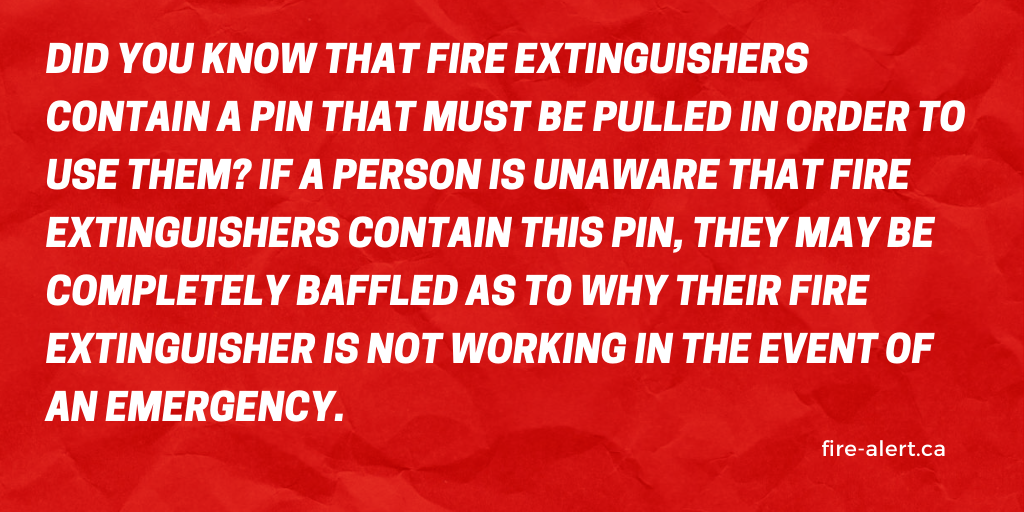
Did you know that fire extinguishers contain a pin that must be pulled in order to use them? If a person is unaware that fire extinguishers contain this pin, they may be completely baffled as to why their fire extinguisher is not working in the event of an emergency.
Fireline explains more on the importance of removing the fire extinguisher’s pin:
“Pins exist for a reason on fire extinguishers and that is to prevent an unintended discharge. The pin is located on the handle. Always remember to pull the pin or you will not be able to use your fire extinguisher. Many jurisdictions require what are known as tamper seals. Fire extinguisher tamper seals protect the pin from being accidentally pulled from a fire extinguisher and can be used to identify a fire extinguisher that has already been discharged. When you see the tamper seal on a fire extinguisher, simply twist and pull the pin and you will be good to go. This is one way to avoid those pesky fire extinguisher mistakes.”
Rushing To Stop A Fire
It’s important to recognize when you should be using your fire extinguisher and when you should take a step back and head to safety. For example, large and out of control fires are too dangerous to attempt to put out with a fire extinguisher, and can end up putting you in serious danger if you rush to put it out.
Hseblog.com explains why considering your own safety in the event of a fire is more important than rushing to try to put it out:
“When a fire occurs, many people rush to get the fire safety equipment without stopping to think of their safety from fire. A fire accident causes depression and stress, but it is necessary to do your best to remain calm and think about your actions about controlling the fire. If the fire is enormous to stop or settle with the fire extinguisher and there are the possibilities that you will be injured or affected by trying to fight the fire, leave the building quickly and call a helpline.”
Fire-Alert takes pride in equipping homeowners, commercial businesses and government buildings with all necessary fire safety devices to ensure the well-being of families and employees across the nation. Reach out to us using our contact form to find out more.
Fire suppression systems come in many different forms, including the popular water mist systems. However, they all serve the same purpose, which is suppressing or extinguishing a fire. While foam fire suppression systems are similar to water sprinkler systems, they combine both water and foaming agents in order to put out large or difficult to distinguish fires. In this article, we take a look at how foam fire suppression systems work, as well as the pros and cons of implementing this type of fire safety system.
How Do Foam Fire Suppression Systems Put out Fires?
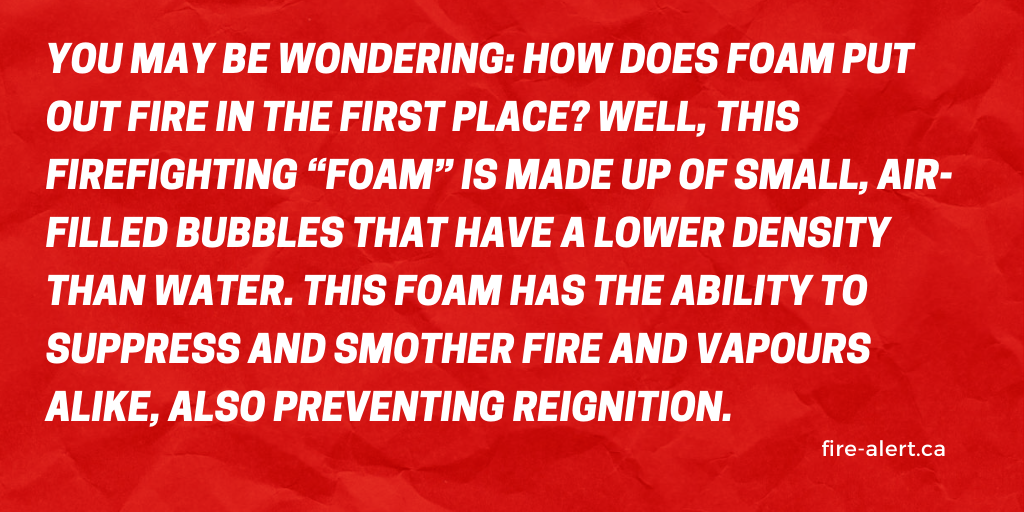
You may be wondering: how does foam put out fire in the first place? Well, this firefighting “foam” is made up of small, air-filled bubbles that have a lower density than water. This foam has the ability to suppress and smother fire and vapours alike, also preventing reignition.
Fireline tells us more on how foam fire suppression systems are able to put out fires:
“Foam fire suppression systems extinguish a fire by cooling and separating fuel from oxygen. In more technical terms, the systems are used to “cool the fire and coat the fuel that the fire consumes to prevent contact with oxygen and reduce any combustion ability.” To do this, the extinguishing agent blankets or smothers the surface of the fuel. The foam’s water content will then cool the fuel, and the area of foam that is covering the fuel will stop the combustion of flammable vapors. High expansion foams work by completely filling the volume of a building from floor to ceiling to suffocate and cool the fire.”
How Do Foam Suppression Systems Discharge?
Foam suppression systems are built very similarly to a water sprinkler system, which works by storing water that then flows through a network of pipes, and is discharged through nozzles. However, the main difference between a water sprinkler system and a foam suppression system, is the addition of the foaming agent.
FireSystems.net further explains how foam suppression systems are then able to put out large and hard to distinguish fires:
“The foaming agent is stored separately from the water and the two are mixed within the piping system prior to discharge. At the end of the piping is a nozzle. The foaming agent is added or ejected into the water at the very last moment before discharge. When the water mixes with the foaming agent, expansion occurs and creates an immense coverage of foam to fill expansive areas.”
Pros and Cons of a Foam Suppression Fire System
Of course, the biggest advantage of a foam suppression fire system is the fact that it does an excellent job at distinguishing fires, and is often much more effective than a water sprinkler system. However, there is one major con to a foam fire suppression system: it’s messy.
IntegratedFireSystems.com tells us more on why the clean up of a foam suppression system may be a deterrent for some:
“A disadvantage to a Foam Water Fire Sprinkler System is that is can be messy to clean up. In the event of a fire sprinkler system going off, you usually will have water damage. But in the event a Foam Water Fire Sprinkler System you will have chemical foam to clean up. This negative usually does not outweigh the positives when it comes to the buildings that they protect, but it is still something that should be kept in mind.”
Fire-Alert takes pride in equipping homeowners, commercial businesses and government buildings with all necessary fire safety devices to ensure the well-being of families and employees across the nation. Reach out to us using our contact form to find out more.
Every residential and commercial building should include a fire safety plan, which should be specific to the property or business. Conducting an audit or review of the factors that could affect fire safety can play an important part in creating a plan that will cause as little damage as possible, as well as ensuring that you can safely evacuate your employees. In this article, we take a look at 4 things a fire safety plan should include when it comes to your commercial building.
Reporting the Emergency
It’s important to establish how you are going to report the emergency to your employees in the event of a fire. It’s not uncommon in large buildings for employees to not be able to hear a smoke alarm. And even if they do, they may be unsure whether it’s a false alarm and hesitate to evacuate.
CollisionRepairmag.com gives us some options on how to notify your employees in the event of an emergency:
“The first and one of the most important parts of a safety plan is the procedure for notifying occupants and others of the emergency. In buildings without a fire alarm it is important to identify the best means for alerting people to the emergency (e.g. shouting “fire”, blowing an air horn or whistle, using a megaphone, hand bell, strobe light, intercom or other signaling device). If work takes place in a noisy environment, the plan should also identify a secondary method for alerting people.”
Emergency Procedures
A fire safety plan must include emergency procedures. Emergency procedures should not only include how you intend to safely evacuate your employees, but should include in detail every procedure you intend to follow to ensure that the fire is extinguished as soon as possible.
Muskoka Lakes Fire Rescue tells us what should be included in your fire safety plan when it comes to emergency procedures:
“The emergency procedures to be used in case of fire including sounding the fire alarm, notifying the fire department, provisions for access for fire fighting, instructing occupants on procedures to be followed when the fire alarm sounds, evacuating endangered occupants and confining, controlling and extinguishing the fire”.
Site Drawings

Site drawings are often stored in an easy to access fireproof box on a commercial property and in the case of high-rise residential properties. Site drawings are an invaluable addition to your fire safety plan, as they map out for firefighters exactly where such important items as fire fighter access points are located.
WorksiteSafety.ca explains what site drawings in a fire safety plan usually entail:
“The Fire Safety Plan includes drawings of the property showing locations of fire protection systems for use by the occupants and firefighters. Site drawings must include a number of items, such as Fire Fighter Access Points, Fire Exits, The Annunciator, Fire Hydrants, Standpipes, The FF Box, Gas Shutoffs, and Mechanical Rooms.”
Fire Drills
At a minimum, fire drills are required in the workplace every 12 months. However, workplaces with an increased amount of fire hazards may wish to consider practicing fire drills every 3 months. Fire drills are an important part of a fire safety plan, as they not only help your employees prepare for an emergency, but also help to make improvements to the existing plan should issues present themselves.
Fire-Alert takes pride in equipping homeowners, commercial businesses and government buildings with all necessary fire safety devices to ensure the well-being of families and employees across the nation. Reach out to us using our contact form to find out more.
When it comes to fire safety in the workplace, nothing is more important than implementing the use of fire prevention equipment and procedures. The National Fire Protection Association (NFPA)’s fire code states that commercial, industrial, and residential buildings must have fire extinguishers on hand, as well as other types of fire safety equipment, in order to minimize the spread of a potentially devastating fire. In this article, we take a look at the four main kinds of fire safety equipment you are required to have in your work facility. It’s important to note that all employees must be trained to operate this equipment in the event of an emergency.
Fire Extinguishers
While fire extinguishers are commonly the first line of defence when it comes to eliminating fires before they spread, many of us don’t know how to use them. It’s not only essential that fire extinguishers are installed in your building, but that all employees are fully confident in how to use one in the event of a fire.
Creative Safety Supply tells us why fire extinguishers are mandatory in the workplace and details how to use one:
“All facilities are required to have fire extinguishers on site. These extinguishers should be easy to access, highly visible, properly charged, and inspected regularly. They’re often the first line of defense and commonly used to extinguish or contain fires, which prevents costly damage and saves lives. They should be installed high on the wall and located near an exit. When using a fire extinguisher, remember the PASS method: Pull the pin, aim low, squeeze the lever slowly, and sweep from side to side.”
Smoke Detectors
The Occupational Safety and Health Administration (OSHA) has strict requirements for how many smoke detectors must be in a building, whether commercial or residential. Making sure you abide by these guidelines is essential to adequate fire prevention in the workplace.
NTT Inc. lays out what the OSHA requirements are when it comes to smoke detectors:
“Do you know exactly how many detectors your workplace needs? OSHA GUIDELINES state that every room, storage area, and hallway should have its own smoke detector. Large spaces might require two detectors, depending on the range of the detectors you are using. Even if you think your workplace has plenty of fire detectors, it’s a good idea to go through each room and make sure, as well as to check the range of your smoke detectors in case larger rooms and hallways require more than one.”
Carbon Monoxide Alarms
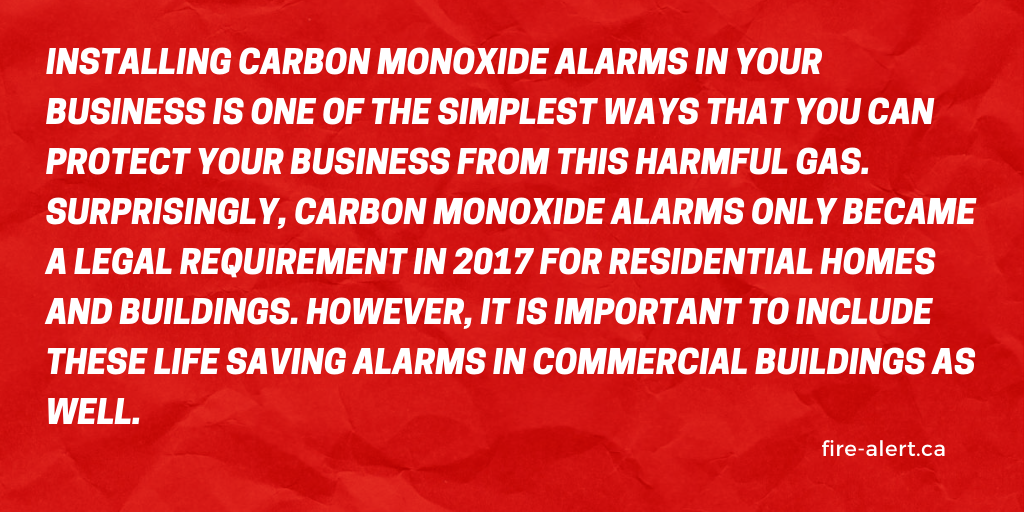
Installing carbon monoxide alarms in your business is one of the simplest ways that you can protect your business from this harmful gas. Surprisingly, carbon monoxide alarms only became a legal requirement in 2017 for residential homes and buildings. However, it is important to include these life saving alarms in commercial buildings as well.
StanleySecurity.ca explains why carbon monoxide detectors are important to install not only at home, but in the workplace as well:
“CO detectors for business are an inexpensive, effective way to protect your business from harmful gas. They work by monitoring airborne concentration levels (parts per million) of carbon monoxide over time, and alerting you with sounds and visual signals when harmful levels are present. CO detectors are designed to sense both low levels of CO over long periods, and high levels over short periods.”
Fire Suppression Systems
Fire suppression systems are an essential part in not preventing property loss in the case of an extreme fire, but preventing both serious injury and death. Fire sprinkler systems have the capability to drastically reduce smoke, flames and heat and can virtually eliminate a fire that is rapidly spreading.
Fire-Alert takes pride in equipping homeowners, commercial businesses and government buildings with all necessary fire safety devices to ensure the well-being of families and employees across the nation. Reach out to us using our contact form to find out more.
The risk of a fire in a manufacturing and warehouse facility is high, with the various equipment and machinery used posing an extreme fire hazard if not properly maintained. This is why warehouses and manufacturers should always take fire safety seriously, to make sure that their facilities are always prepared for a potential fire. In this article, we take a look at 3 warehousing and manufacturing safety tips to help make sure that these facilities have the right safety precautions in place, should a potentially devastating fire break out.
Have An Evacuation Plan For Your Employees
As with any workplace, it’s important to have an evacuation plan laid out – especially in the case of a warehouse or manufacturing facility, where you may need to evacuate dozens of employees. By having an evacuation plan in place, you can make sure that your employees are able to exit safely, avoiding more accidents caused by panic and stress.
Keystone Fire Protection Co. explains why it’s essential to have an evacuation plan put in place for your employees:
“If a fire does occur in a facility, the number one priority is making sure that the employees are able to exit the building quickly and safely. A fire can cause severe stress and fear in individuals, which in turn can result in panicked reactions and avoidable accidents. Warehouses and manufacturers can counteract this result by establishing an appropriate evacuation plan that directs all employees to the nearest exits in a calm and controlled manner. Furthermore, requiring employees to regularly review the evacuation plan or practice evacuating in a fire drill can aid employees in feeling prepared if a fire occurs and provide them the tools to respond appropriately in an emergency.”
Carry Out a Risk Assessment
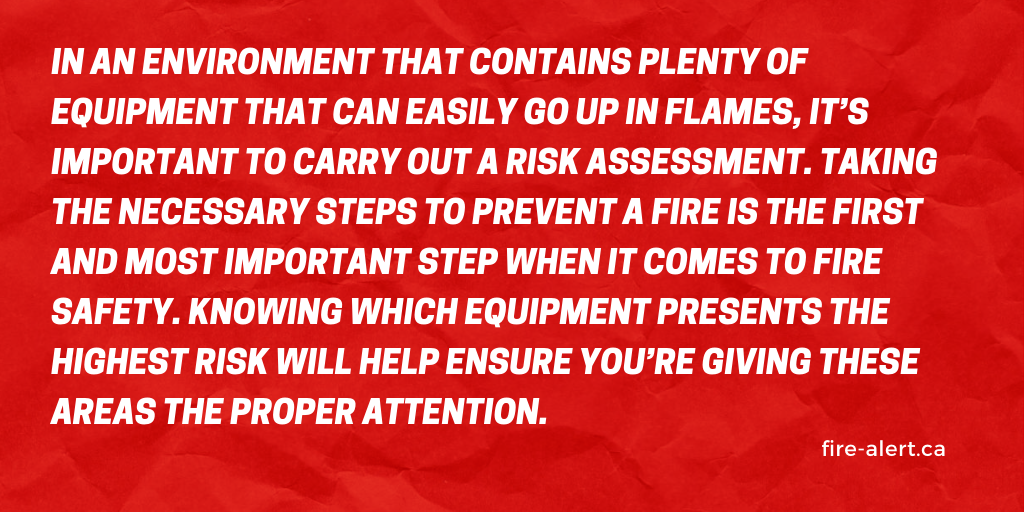
In an environment that contains plenty of equipment that can easily go up in flames, it’s important to carry out a risk assessment. Taking the necessary steps to prevent a fire is the first and most important step when it comes to fire safety. Knowing which equipment presents the highest risk will help ensure you’re giving these areas the proper attention.
Workplace Safety & Preventative Services (WSPS) tells us why carrying out a risk assessment is important in a warehouse or manufacturing facility:
“What are your fire hazards (ex. hot work, electrical, charging stations, etc.)? Who is at risk and how can you control these risks? Hot work requires a permit and hazard analysis before work can proceed. Because the configuration of your racking systems and aisles change frequently, risk assessments should be ongoing.”
Use Safe Inventory Storage Methods
Warehouses that are full of not only machines, but various stock and inventory pose a serious fire hazard. The more crowded a space is, the more likely an accident is to occur, so it’s important to make sure that you are practicing safe inventory storage methods if you’re not already.
Marco Fire explains why practicing safe inventory storage methods and establishing safe habits can make all the difference when preventing a fire:
“Although fire protection systems are great at reducing the negative impacts of a fire, they do not necessarily prevent a fire from occurring. In order to prevent a fire from starting in your warehouse this holiday season, start practicing safe inventory storage methods right now. One of the biggest hazards during the holiday season is the increased inventory. This leads to overcrowding and accumulation of waste. However, these habits are some of the riskiest for your warehouse. It’s important to establish safe habits like keeping sprinkler heads clear of products, leaving space between pallets, and regularly eliminating cardboard waste.”
Fire-Alert takes pride in equipping homeowners, commercial businesses and government buildings with all necessary fire safety devices to ensure the well-being of families and employees across the nation. Reach out to us using our contact form to find out more.
Emergencies can happen at any moment and often when we least expect them. And while we as humans are able to map out a plan in the event of a fire emergency, our pets will often not be aware of what’s going on. As our pets guardians and protectors, we are responsible for ensuring that they are able to exit safely in the event of a fire. But what measures can we take to ensure that our pets are taken care of in the event of an emergency? We’re going to take a look at pet fire safety tips to ensure that both you and your furry friends are prepared in the event of a fire.
Note Where Your Pets Like to Nap or Hide
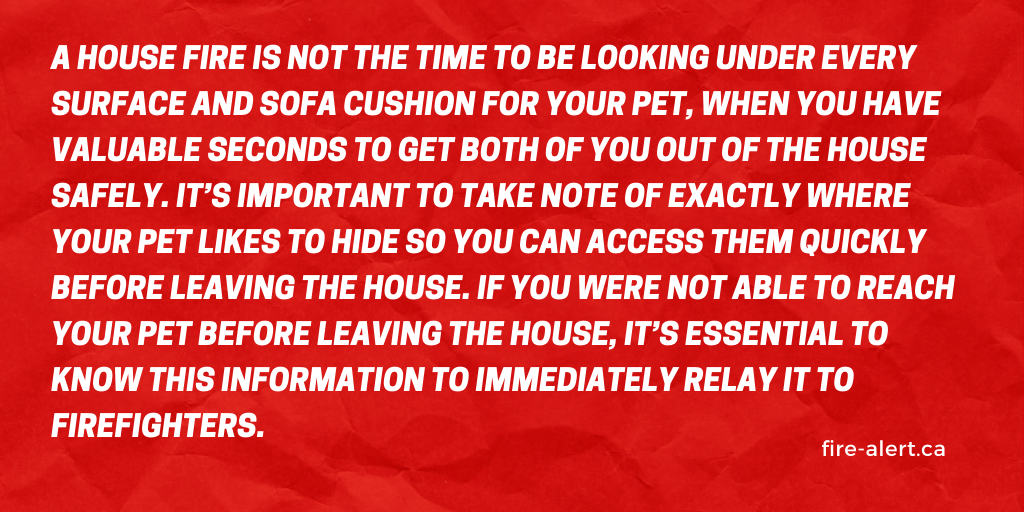
A house fire is not the time to be looking under every surface and sofa cushion for your pet, when you have valuable seconds to get both of you out of the house safely. It’s important to take note of exactly where your pet likes to hide so you can access them quickly before leaving the house. If you were not able to reach your pet before leaving the house, it’s essential to know this information to immediately relay it to firefighters.
ASPCA.org tells us why knowing where your pet likes to hide and practicing escape procedures with them can make all the difference in leaving your home safely:
“This is important in the event that you must evacuate your home quickly. Remember that pets can be exponentially more difficult to round up if they sense stress—especially cats! Practice crating your pets in advance to make it a positive experience so they don’t go running when you pull out their crate during any type of emergency.”
Keep Pets Visible When Away From the Home
Whether you own a cat or a dog, doing your best to keep them visible while you’re away from the home will be incredibly valuable in the event of an emergency. While we often give our animals free reign of the house while we’re at work or running errands, it’s important to quickly narrow down their location in the event of a fire.
RedCross.org explains how you can prepare your pet for quick evacuation in the event of a fire when you’re not home:
“Keep pets near entrances when away from home. Keep collars on pets and leashes at the ready in case firefighters need to rescue your pet. When leaving pets home alone, keep them in areas or rooms near entrances where firefighters can easily find them.”
Consider Monitored Smoke Detectors
Standard smoke detectors can only draw so much attention to your household if you’re not home. By the time a neighbour hears your smoke alarm and realizes you’re not home, it will likely be far too late – if they notice at all. A monitored smoke detector can make all the difference in having your home tended to quickly in the event of a fire.
Better Cities For Pets explains the benefit of investing in a monitored smoke detector:
“While it’s obviously vital to have working smoke detectors in your home, for pet fire safety you may want to think about upgrading a step further. Consider using monitored smoke detectors, says the American Kennel Club. These devices are connected to a monitoring center so emergency responders can be contacted when you’re not home.”
Fire-Alert takes pride in equipping homeowners, commercial businesses and government buildings with all necessary fire safety devices to ensure the well-being of families and employees across the nation. Reach out to us using our contact form to find out more.